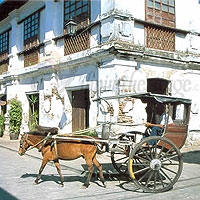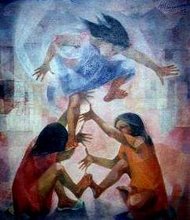Kulitan is a writing system used for writing the Kapampangan language. Kapampangan is mainly spoken in the provinces of Pampanga, Tarlac, Bataan, and Nueva Ecijia in the Philippines. Kulitan is an abugida or alphasyllabary writing system, where the consonantal characters possess a default vowel sound that can be altered with use of diacritical marks. Kulitan is an Indian-inspired script referred to by the natives as Sulat Kapampangan and Pamagkulit. It is written and read vertically from top to bottom and from right to left.
Kulitan is basically made up of Indûng Súlat (mother characters),which are made up of consonants with an inherent vowel.A, I, U, E, O, GA, KA, NGA, TA, DA, NA, LA, SA, MA, PA, BA.
Anak Súlat (offspring characters) consist of vowel diacritics, which change the inherent vowel.
Tuesday, March 3, 2015
Friday, January 19, 2007
a little history...
 Today, the Philippines is centered toward Manila and people from Manila or Manilenos as we refer to them, act as if they are what makes the Philippines great. Because of this attitude, I see some Kapampangans who would say they are from Manila and would speak Tagalog...a denial of their culture and their ancestors thinking they are second to Manilenos. This, I think, is pretty sad. We Kapampangans should be proud of who we are and speak our language proudly and not be ashame of it. It is, after all, the Kapampangans who made the Philippines known to the outside world, with their bravery, products, beautiful women, delicious food, and more.
Today, the Philippines is centered toward Manila and people from Manila or Manilenos as we refer to them, act as if they are what makes the Philippines great. Because of this attitude, I see some Kapampangans who would say they are from Manila and would speak Tagalog...a denial of their culture and their ancestors thinking they are second to Manilenos. This, I think, is pretty sad. We Kapampangans should be proud of who we are and speak our language proudly and not be ashame of it. It is, after all, the Kapampangans who made the Philippines known to the outside world, with their bravery, products, beautiful women, delicious food, and more.From my readings, I learned that Kapampangans were descendants of Malayan pioneers from the Malay Peninsula. In 1571, the Spaniards organized Pampanga as a province in order to meet their needs. Pampanga, which is about 850 square miles in area and presently inhabited by more than 1.5 million people, had its present borders drawn in 1873. During the Spanish occupation, it was considered one of the richest provinces in the Philippines. It was also very interesting to find out that most of the pioneers originated from Pampanga to include, education, movie industries, farming, and other things that made the Philippines what it is today.
Angeles City, the place I call home, was used as the outpost called Culiat of the town of San Fernando in 1796. It was Don Angel Pantaleon de Miranda who took the initiative to clear the wooded area and cultivated it for rice and sugar. An old U.S. military base known as Clark Air Base, was then the major industrial and commercial center lead by General Brigadier Romeo Soliman David of San Fernando. It was here where the first hotels, restaurants, and recreation centers, as well as schools were first established.
Manila was not always the capital of the Philippines. During the British occupation of Manila in 1762-63, Bacolor was the capital of the Philippines for almost three hundred years. It was also in Bacolor where the oldest Philippine trade school was established by the Spaniards.
Lubao is where most well-known movie industry personalities originated from. Numerous directors, producers, writers and cinematographers, such as Rogelio and Jaime de la Rosa, Rudy Fernandez, Letty Alonzo, and many others.
Pampanga is also the home of the brave. Macabebe is know for its soldiers under Rajah Soliman. The vast majority of the soldiers who served in the United States Army are largely from Masantol area. General Maximino Hizon and General Rafael Maniago from Masicu (now known as Mexico) lead the modern Philippine Army. Finally, it was the Kapampangans who established democracy in the Philippines. Starting with former President Diosdado Macapagal, who preserved democracy in the country; Jose Abad Santos, who toppled dictatorship; Senator Benigno Aquino, who was murdered by a dictator while trying to re-establish democracy in the country; and thousand others who died during the Philippine revolution.
Kapampangans are not only brave and creative, they are also artistic. San Fernando, for example, is known today as the "Philippine Christmas Village," because of their beautiful lanterns. Another example is Macabebe and their textiles. Beautiful textiles comes from this region of Pampanga. Finally, Santo Tomas is known for its pottery industry.
Kapampangans are also well-known for their cuisine. Their Malayan origination combined with the Spanish and American influence makes the Kapampangan cuisine among the best in the Philippines.
Saturday, December 23, 2006
pili na ka atse!
Perhaps the places I enjoy visiting whenever I visit Angeles are the wet market. I love seeing all kinds of vegetables and flowers that can only be found in that region of the Philippines. Today, Angeles City has number of modern grocery stores (e.g., Robinsons, SM, Pure Gold, etc.) and not too many people visit the traditional market places anymore, which I think is sad. For me, the best places to shop for food is still the traditional markets...a little smelly but more fun and exotic.
Friday, December 22, 2006
ing mumunang chapter na ning kakung edukasyun...
This is the beginning of my quest to learning more about my heritage--Kapampangan. I was born in Pampanga but I really don't know much about it. I attended school in Angeles City only up until 6th grade and then immigrated to the United States.
Here, I will post all things Kapampangan.
Here, I will post all things Kapampangan.
Subscribe to:
Posts (Atom)



